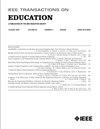Helping First-Year University Students to Overcome the Threshold Concept of Ohm’s Law
IF 2
2区 工程技术
Q2 EDUCATION, SCIENTIFIC DISCIPLINES
引用次数: 0
Abstract
Contribution: This article presents significant contributions in the field of understanding and addressing misconceptions (MCs) related to Ohm’s law. First, it provides a comprehensive list and detailed description of 16 MCs commonly observed among students, and identifies and emphasizes 11 good practices that educators can adopt to effectively address these MCs to promote conceptual understanding. Second, this article offers two conceptual maps, serving as a valuable guide for practitioners. Lastly, this work presents an in-depth analysis of a flipped classroom intervention aimed at both overthrowing students’ MCs and promoting students’ metacognition. Background: A deep understanding of Ohm’s law holds immense importance for first-year engineering students because it serves as a fundamental principle in electrical engineering and forms the basis for analyzing and designing electrical circuits. Research Questions: Which MCs prevent students from understanding Ohm’s law? Which are their prevalence and persistence? Does the classroom dynamics proposed in this research improve the understanding of Ohm’s law? Does it transform the students’ previous conception? and Do students retain the new conception? Methodology: Two student groups from different degrees were selected as participants in the study. Both student groups were assessed using the conceptual Test DIRECT 1.0 as a pretest and DIRECT 1.2 as a post-test and delayed post-test. Quantitative and qualitative analyses were carried out to determine significant differences in learning outcomes before and after instruction. This study also provides rich insights into the underlying MCs and the effectiveness of the instructional approach in addressing them. Findings: The research findings contribute to the existing knowledge by identifying a new MC, introducing new good practices, developing a new conceptual map for power, showcasing the effectiveness of a classroom intervention, and deepening the understanding of the relationship between test DIRECT 1.0 and 1.2 and MCs. These findings have implications for educational practices, curriculum development, and instructional approaches, ultimately aiming at improving students’ understanding of Ohm’s law and related electrical concepts.帮助大一学生克服欧姆定律的阈值概念
贡献:本文在理解和解决与欧姆定律相关的误解(MCs)方面做出了重大贡献。首先,它提供了一个全面的列表和详细的描述16个普遍观察到的学生mc,并确定和强调了11个良好的做法,教育工作者可以采取有效地解决这些mc,以促进概念理解。其次,本文提供了两个概念图,为实践者提供了有价值的指导。最后,本研究对翻转课堂干预进行了深入分析,旨在推翻学生的mc和促进学生的元认知。背景:深刻理解欧姆定律对一年级工程专业的学生来说非常重要,因为它是电气工程的基本原理,是分析和设计电路的基础。研究问题:哪些mc阻碍了学生理解欧姆定律?它们的普遍性和持久性是什么?本研究中提出的课堂动态是否提高了对欧姆定律的理解?它是否改变了学生以前的观念?学生是否保留了新概念?方法:选取两组不同学位的学生作为研究对象。两个学生组都使用概念测试DIRECT 1.0作为前测,DIRECT 1.2作为后测和延迟后测进行评估。进行了定量和定性分析,以确定教学前后学习成果的显著差异。本研究也提供了丰富的见解,以了解潜在的MCs和教学方法的有效性,以解决他们。研究发现:研究结果通过识别新的MC、引入新的良好实践、开发新的权力概念图、展示课堂干预的有效性以及加深对test DIRECT 1.0和1.2与MC之间关系的理解,对现有知识做出了贡献。这些发现对教育实践、课程开发和教学方法具有启示意义,最终旨在提高学生对欧姆定律和相关电学概念的理解。
本文章由计算机程序翻译,如有差异,请以英文原文为准。
求助全文
约1分钟内获得全文
求助全文
来源期刊

IEEE Transactions on Education
工程技术-工程:电子与电气
CiteScore
5.80
自引率
7.70%
发文量
90
审稿时长
1 months
期刊介绍:
The IEEE Transactions on Education (ToE) publishes significant and original scholarly contributions to education in electrical and electronics engineering, computer engineering, computer science, and other fields within the scope of interest of IEEE. Contributions must address discovery, integration, and/or application of knowledge in education in these fields. Articles must support contributions and assertions with compelling evidence and provide explicit, transparent descriptions of the processes through which the evidence is collected, analyzed, and interpreted. While characteristics of compelling evidence cannot be described to address every conceivable situation, generally assessment of the work being reported must go beyond student self-report and attitudinal data.
 求助内容:
求助内容: 应助结果提醒方式:
应助结果提醒方式:


